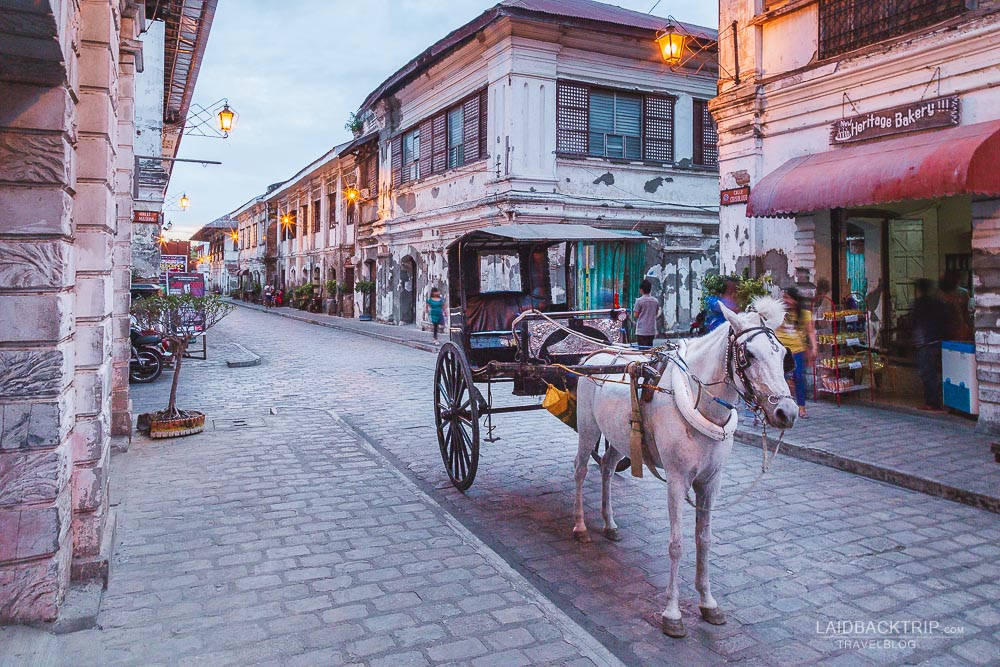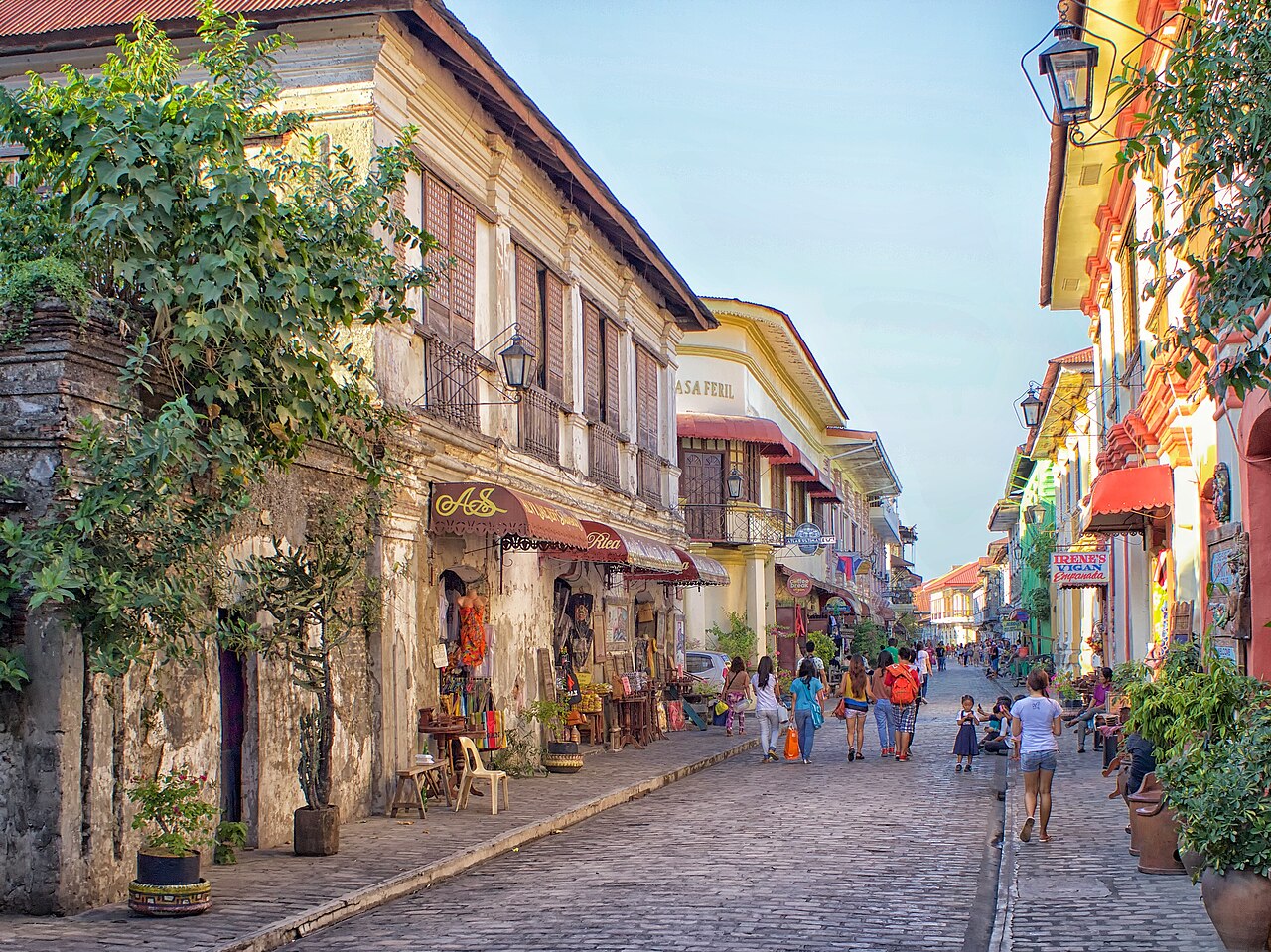



Vigan is a city in the Philippines, on the west coast of Luzon island. It's known for its preserved Spanish colonial and Asian architecture. Calle Crisologo dominates the Mestizo district, with its cobblestone streets, malecón, horse-drawn carriages and rustic mansions. Near the white baroque Vigan Cathedral are Plaza Salcedo, offering fountain light shows, and Plaza Burgos, known for its street-food stalls. ― Google
Age: About 453 years
Area: 28.86 km²
Mayor: Jose C. Singson
Barangays: 39 (see Barangays)
Cityhood: January 22, 2001
District: 1st district
Elevation: 69 m (226 ft)
November to April:
This is the dry season, ideal for sightseeing and walking around Vigan's historical streets. The weather is more comfortable, and there are fewer chances of rain, making it perfect for exploring the town's attractions.
May to October:
The rainy season brings occasional showers, which can make outdoor activities less enjoyable. However, traveling during this time means fewer crowds and cheaper accommodation rates.
By Air:
The nearest airport to Vigan is Laoag International Airport in Laoag, which is about 2-3 hours away by land. You can fly to Laoag from Manila or Cebu and then take a bus or private van to Vigan.
By Bus:
Several bus lines operate routes from Manila to Vigan. Travel time is around 8-10 hours. Some of the popular bus companies include Partas, Virginia Bus, and Fariñas Transit.
By Private Car:
If you prefer more flexibility, you can drive from Manila to Vigan, which will take approximately 8-9 hours via the North Luzon Expressway (NLEX) and Tarlac-Pangasinan-La Union Expressway (TPLEX).
A historic street that takes you back in time with its cobblestone roads, Spanish-era architecture, and traditional houses. It’s the most iconic attraction in Vigan, where you can also find quaint shops selling local products, souvenirs, and handicrafts.
A beautiful example of Spanish colonial architecture, this Catholic church is one of the oldest in the country, built in the 16th century. It features impressive Baroque-style interiors and is a must-visit for history and architecture enthusiasts.
The main public square of Vigan, surrounded by historical buildings. It’s a great spot to relax and enjoy local food or witness cultural performances. The dancing fountain here is also a popular attraction during the evening.
The ancestral home of former President Elpidio Quirino, Syquia Mansion is now a museum showcasing a collection of Filipino antiques, artworks, and historical artifacts. The house itself is a wonderful example of a traditional Vigan-style mansion.
This towering structure, located in the nearby town of Bantay, offers panoramic views of Vigan and its surroundings. The tower is also historically significant, as it was used as a watchtower during the Spanish period to spot incoming invaders.
This area is dedicated to showcasing traditional crafts and local artistry. You can find handwoven abel Iloco fabrics, pottery, and woodwork, as well as experience the local way of life.
This pottery-making factory is where you can witness the traditional method of creating burnay jars (handmade earthenware). It’s a great spot to learn about the region’s craft heritage and even try making your own pottery.
Kalesa Ride:
One of the best ways to explore Vigan is by taking a traditional kalesa (horse-drawn carriage). This will give you a relaxed tour through the town's historical streets, offering a more nostalgic experience.
Heritage Walk:
Take a walking tour around Calle Crisologo and nearby areas to admire the well-preserved Spanish-era houses, which showcase intricate designs and wooden architecture. Many of these buildings have been turned into museums, shops, and guesthouses.
Try Local Delicacies:
Vigan is famous for its longganisa (local sausage), empanada (a deep-fried pastry filled with egg, pork, and vegetables), and bagnet (crispy fried pork belly). Don’t miss the chance to sample these authentic Ilocos dishes at local eateries.
Watch the Sunset at Vigan River:
Head to the Vigan River and enjoy the peaceful surroundings while watching the sunset. Some areas along the river have cafes and restaurants where you can relax and enjoy the view.
Buy Souvenirs:
Explore the local markets and stores for authentic Vigan handicrafts such as wooden souvenirs, woven items, and delicious local snacks like vigan longganisa, tupig, and empanada.
Luxury:
Hotel Luna: A stylish hotel located near Calle Crisologo, offering luxurious rooms with a touch of history, as well as a museum and an art gallery.
Vigan Plaza Hotel: A heritage hotel offering spacious rooms with a traditional touch and excellent service, conveniently located near the city’s major attractions.
Mid-range:
Gordion Hotel: An affordable yet charming hotel with traditional Ilocos-style rooms and a central location near Calle Crisologo.
The Manor Hotel: A family-friendly hotel offering comfortable accommodations with a relaxed atmosphere.
Budget:
Crisologo Inn: A budget-friendly option with basic but clean rooms, located close to the main tourist spots.
The Villa Angela Heritage House: A simple, affordable guesthouse that gives you the experience of staying in a traditional Vigan-style house.
Must-try dishes:
Vigan Longganisa: Local sausage, often served with rice and vinegar.
Empanada: A deep-fried pastry stuffed with pork, egg, and vegetables.
Bagnet: Crispy fried pork belly.
Tupig: A rice cake made from glutinous rice, sugar, and coconut, traditionally cooked in banana leaves.
Top Dining Spots:
Café Leona: An iconic restaurant serving traditional Ilocos dishes, located along Calle Crisologo.
Bale Asu: A local favorite known for serving delicious bagnet and other Ilocano specialties.
Irene's Empanada: Famous for serving some of the best empanadas in town.
Heritage Preservation:
Vigan is known for its well-preserved Spanish colonial architecture and culture. The town has been recognized as a UNESCO World Heritage Site due to its outstanding historical and cultural value.
Handicrafts:
The region is known for its abel Iloco woven fabrics, woodwork, and pottery. Visitors can see local artisans at work and purchase unique, handcrafted products.
Festivals:
Viva Vigan Binatbatan Festival of the Arts (May-June): A week-long celebration of the town’s cultural heritage, featuring street dancing, parades, and performances that highlight Vigan’s rich traditions.
Raniag Festival (December): Celebrates Vigan’s historical and cultural significance with parades, cultural shows, and a Christmas light competition.
Language:
The primary language spoken in Vigan is Ilocano, but many locals also speak Tagalog and English, especially in tourist areas.